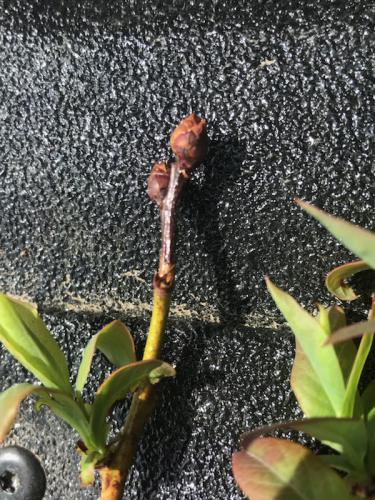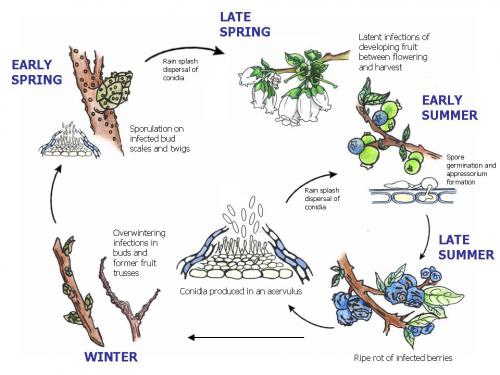Shoot blight in Michigan blueberries
A wet spring may result in more shoot and twig blight. What can you do?

Twig blights in blueberries
Weather conditions have been wet in Michigan and blighted twigs have been found in blueberries (Photo 1). Tip dieback and blighted blossom clusters are the first symptoms growers and scouts find of shoot blights. Various fungi such as anthracnose (Colletotrichum acutatum), phomopsis (Phomopsis vaccinii), botrytis (Botrytis cinerea) and bacteria canker (Pseudomonas syringae) can cause twig blight. Anthracnose (Colletotrichum) is often to blame for twig infections during wet seasons. Colletotrichum infections can be observed by allowing diseased shoots to produce orange spore masses in a plastic bag. Samples can also be submitted to Michigan State University Diagnostic Services for a positive identification.
Scouting for twig blights
To scout for blighted twigs, follow these instructions:
- Pick 10 random bushes throughout your field (include both border bushes and internal ones).
- Count the number of recent brown or dead young twigs/flower clusters.
- If your count is higher than 10 blighted blossoms/twigs per bush (a moderately high incidence), consider applying a fungicide, especially if rain is in the forecast. Note that twigs that are in bloom are the most susceptible to infection.

Photo 2. Tip blight observed in Bluecrop in May 2018. Photo by Bill Foster, CPS.
Control methods for twig blights
Chemical options
Controls are the most effective if they are applied prior to twig blight infections. A twig blight sample this spring was positively identified by MSU Diagnostic Services as bacterial canker. There are no fungicides that control bacteria and no antibiotics are registered in blueberries. Copper is commonly used to control bacterial diseases. The timing window for using copper is early in the season soon after bud break and during early shoot growth before bloom.
Bacterial canker is a disease that is favored by cool, wet conditions. Our weather has changed from cool and wet to warm and wet so that our blueberries are growing faster than the bacteria. Any copper spray now would be a useless revenge spray, which would do little good and might mark the green fruit or damage the remaining flowers. If you are concerned about bacterial canker, target it early next spring, not after bloom.
Research on phomopsis twig blight has shown the most infections occur at bud break. Fungicides should be applied to protect the buds at bud break. Many fungicides have good activity against mummy berry and phomopsis.
Colletotrichum infections require warm and wet conditions. They can occur before, during and after bloom (Photo 3). Fungicide applications should target these infections. There is an anthracnose prediction model on MSU Enviroweather.
As we transition from pre-bloom to post-bloom disease control, careful choice of fungicides to control the disease is important. Several fungicides are rated good to excellent at controlling the various fungi that cause twig blight. MSU Extension annually updates E154, “2018 Fruit Management Guide”. This resource has good information about fungicide choices based on disease and fungicide effectiveness.

Photo 3. Life cycle of Colletotrichum acutatum (causal agent of anthracnose fruit rot) in blueberries. Source: MSU Extension Bulletin E-3039, illustration by Jennifer Pagan.
Other control methods
In addition to chemical options, there are several cultural control strategies you can deploy. For example:
- When plants are dormant:
- Prune out infected canes.
- Avoid wounding the canes.
- Reduce the spread of spores and infection:
- Minimize overhead irrigation.
- Time irrigation to coincide with natural dew formation.



 Print
Print Email
Email




